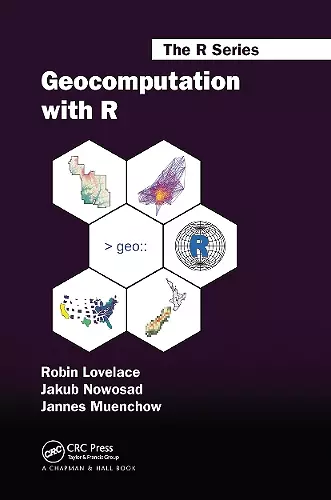Geocomputation with R
Robin Lovelace author Jakub Nowosad author Jannes Muenchow author
Format:Paperback
Publisher:Taylor & Francis Ltd
Published:18th Dec '20
Currently unavailable, and unfortunately no date known when it will be back
This paperback is available in another edition too:
- Hardback£130.00(9781138304512)

Geocomputation with R is for people who want to analyze, visualize and model geographic data with open source software. It is based on R, a statistical programming language that has powerful data processing, visualization, and geospatial capabilities. The book equips you with the knowledge and skills to tackle a wide range of issues manifested in geographic data, including those with scientific, societal, and environmental implications. This book will interest people from many backgrounds, especially Geographic Information Systems (GIS) users interested in applying their domain-specific knowledge in a powerful open source language for data science, and R users interested in extending their skills to handle spatial data.
The book is divided into three parts: (I) Foundations, aimed at getting you up-to-speed with geographic data in R, (II) extensions, which covers advanced techniques, and (III) applications to real-world problems. The chapters cover progressively more advanced topics, with early chapters providing strong foundations on which the later chapters build. Part I describes the nature of spatial datasets in R and methods for manipulating them. It also covers geographic data import/export and transforming coordinate reference systems. Part II represents methods that build on these foundations. It covers advanced map making (including web mapping), "bridges" to GIS, sharing reproducible code, and how to do cross-validation in the presence of spatial autocorrelation. Part III applies the knowledge gained to tackle real-world problems, including representing and modeling transport systems, finding optimal locations for stores or services, and ecological modeling. Exercises at the end of each chapter give you the skills needed to tackle a range of geospatial problems. Solutions for each chapter and supplementary materials providing extended examples are available at https://geocompr.github.io/geocompkg/articles/.
Dr. Robin Lovelace is a University Academic Fellow at the University of Leeds, where he has taught R for geographic research over many years, with a focus on transport systems. Dr. Jakub Nowosad is an Assistant Professor in the Department of Geoinformation at the Adam Mickiewicz University in Poznan, where his focus is on the analysis of large datasets to understand environmental processes. Dr. Jannes Muenchow is a Postdoctoral Researcher in the GIScience Department at the University of Jena, where he develops and teaches a range of geographic methods, with a focus on ecological modeling, statistical geocomputing, and predictive mapping. All three...
"Geocomputation with R offers several advantages. Firstly, it uses up-to-date packages, mainly the 'sf' package for vector processing which was not available at the time the previous books were written. 'sf’' is truly a game-changer in the field of working with spatial data in R. I believe this alone makes writing the new book worthwhile. Secondly, the book offers a very broad overview, trying—and in my opinion succeeding—to encompass all non-statistical themes involved in geo-computation, including subjects such as location and transport modeling in R (chapters 7-8) which were never published before. Thirdly, the book offers a lot of illustrations and clearly demonstrates key concepts in GIS and geo-computation from the R point of view. I believe these characteristics will give the book an advantage and quite possibly make it the most popular choice in the category of spatial analysis in R for several years to come…The book can be used both as reference and as a textbook…The present book will definitely become the main textbook for this course once published."
~Michael Dorman, Ben-Gurion University of the Negev
"This book sets out to explain the key ideas in geocomputation – more specifically manipulating, visualising, modelling and analysing geographical data. A further aim is to achieve all of this using only open source software. Developments of recent years have made this an achievable goal, and this book provides a good starting point for readers wishing to do this… The strength of this book is therefore on the computational aspects (for example producing R-based interactive web sites using shiny) and as a comprehensive overview of the kinds of data one is likely to work with (for example taking care to ensure raster and vector data are both well represented here). The final part showcasing real-world applications is also strong. Another highlight of the book are the exercises at the end of each chapter…Finally, the book comes
ISBN: 9780367670573
Dimensions: unknown
Weight: 620g
354 pages